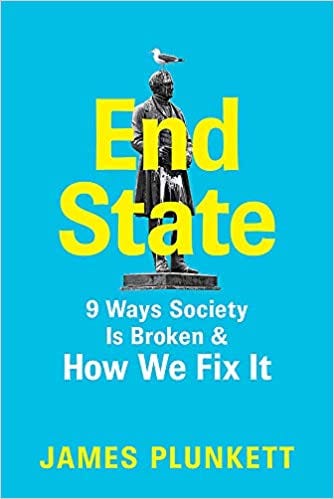Welcome to Just Two Things, which I try to publish daily, five days a week. Some links may also appear on my blog(https://thenextwavefutures.wordpress.com) from time to time. Links to the main articles are in cross-heads as well as the story.
#1: Remaking the social contract
The economist and now academic Diane Coyle is a voracious reader of (mostly) serious books, and one of the pleasures of her long-running blog The Enlightened Economist is her short reviews of her reading.
I noticed her recent review of James Plunkett’s bookEnd State: Nine Ways in Which Society Is Broken And How We Fix It, which is an addition to the recent wave of books on re-making the social contract. (See also Mark Carney, Values, and Manouche Shafik, What We Owe Each Other, for example.
On the strength of her review, Plunkett seems more interested in political economy than some of the others:
the first chapter focuses on over-concentrated markets and the adverse consequences in terms of power and inequality. The second goes on to consider the many ways in which concentrated markets act against the interests of customers, for example by penalising inertia or personalising prices or using dark patterns. Plunkett writes that regulators have been too slow to understand that their intellectual framework needed to adapt to these phenomena, too often assuming that with better information consumers could make better choices. “The deep intellectual underpinnings of public policy,” he argues, “have become unfit for purpose.” They have assumed for too long that the textbook model of markets, with limited market failures, reflected reality.
There are sections on work, on opening up learning and education, and on leisure. Plunkett is a fan of UBI (universal basic income); Coyle not so much. Plunkett is keen on modernising government, Coyle more sceptical on the prospect for this under present conditions, certainly in the UK. This leads her to make a more general point about this ‘social contract’ literature:
it’s terrific to have lots of brilliant authors identifying problems and suggesting fixes, but where is the political leadership and vision to implement a new social contract? The advantage of End State‘s focus on ‘fixes’ is that some of them might get done. We won’t see education and training reform at massive scale, but tougher competition policy – very possibly.
#2: The limits of smart cities
I wrote a piece a few months ago suggesting that the policy appetite for the “smart city” agenda had faded during the pandemic.
More evidence of this overall trend appeared in Wired magazine when it wrote recently about the outcome of the Columbus, Ohio smart city project.
In 2016 Columbus won a US government policy competition—the Smart City Challenge—that was worth $50 million. The competition, says Wired was “conceived as a down payment to jump-start one city’s adaptation to the new technologies that were suddenly everywhere.” The city’s winning bid “It laid out plans to experiment with Wi-Fi-enabled kiosks to help residents plan trips, apps to pay bus and ride-hail fares and find parking spots, autonomous shuttles, and sensor-connected trucks.”
Five years on, it hasn’t quite worked out that way. This is, admittedly, partly because the pandemic hit just as some of the projects were getting started, but nonetheless, the results weren’t great:
Six kiosks placed around the city were used to plan just eight trips between July 2020 and March 2021. The company EasyMile launched autonomous shuttles in February 2020, carrying passengers at an average speed of 4 miles per hour. Fifteen days later, a sudden brake sent a rider to the hospital, pausing service. The truck project was canceled. Only 1,100 people downloaded an app, called Pivot, to plan and reserve trips on ride-hail vehicles, shared bikes and scooters, and public transit.
Of course, that’s not quite how the city has framed it. But it does acknowledge that the city got a bit distracted by the technology. Some of the smart city projects are going to continue, but with a different focus. Jordan Davis, director of Smart Columbus, says
the focus will be, “How do we use technology to improve quality of life, to solve community issues of equity, to mitigate climate change, to achieve prosperity in the region?”
One of the lessons from the project is that $50 million dollars isn’t a whole lot of money to transform a city, especially when spread over five years. Another is that although one of the reasons that Columbus won was because it lined up a slew of private sector partners, it turns out that private sector businesses aren’t the best judges of aligning investment against public impact.
Nonetheless, running the program during the pandemic did lead to some valuable lessons. The autonomous shuttle became a food delivery service; residents with cognitive difficulties used an app to help them navigate public transit; pregnant women used a shared-vehicle app to help them get to medical appointments. Some of the projects started under the Smart Challenge project will continue, and the city also plans to roll out broadband access to people who don’t have it—another pandemic lesson.
So maybe Wired’s note in the article captures it better:
The “smart city” was a hard-to-pin-down marketing term associated with urban optimism. Today, as citizens think more carefully about tech-enabled surveillance, the concept of a sensor in every home doesn’t look as shiny as it once did.
And going forward, says Program Director Jordan Davis:
the city will rely more on “empathy and engagement,” rather than “‘This is a really cool tech that's coming out of the private sector.’”
j2t#140
If you are enjoying Just Two Things, please do send it on to a friend or colleague.




